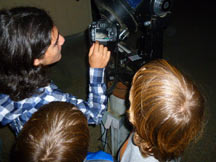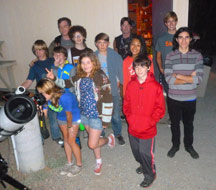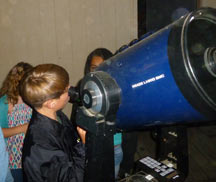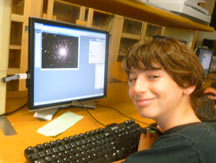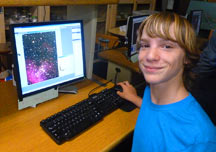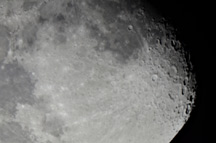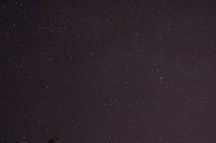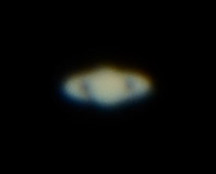
This, my first CYSI class, turned out to be a big success. We had a wonderfully energetic and enthusiastic bunch of middle schoolers who were a pleasure to see each night. Dave McKulle and I thoroughly enjoyed helping teach them how astronomers do imaging and to help them to get their own astronomical photographs. We made use of our new Nikon D7000 digital SLR camera for high magnification imaging of the moon and Saturn. And we used the dome scope 12" Meade with its sophisticated computer control of the mount, SBIG CCD camera, and sky projection software.
We had clear skies every night except the first, which we still made good use of at the observatory by doing a detailed tour of the equipment and how it all operates together.
|
Our teams! Breanna examines the moon through our 8" f/4 Meade Schmidt Newtonian reflector. Note all the rabbit ears ("V" for victory?) |
Amandee's strong first choice was the Veil Nebula - she fairly jumped up to grab it as we decided in the classroom on which objects our teams would go for at the Big Scope. And a great choice it was - the red and blue shock-driven emission lines glow as the first 5-minute image is converted to color. |
Back in the classroom, the photos get the full processing - CCDOPS, then Registax, then Photoshop to polish up the masterpiece. Lilli got her team's first deep-sky object on Tuesday, but begged and cajoled me "Can we do M101 too? Please? Please-please?. With all the clear skies - yeah, we had the opportunity, and on Thursday we put her at the controls of Spock and got two nice 5-minute images. Here she's polishing it up in Photoshop |
|
On Wednesday a new star - a nova! - exploded in Delphinus - the brightest nova in decades! We got photos and also examined it up close in the big Dob scope. |
Gabe works on his beautiful photo stack of the Eagle Nebula. The famous Hubble Space Telescope images of the "columns of creation" within, captured his imagination, and they show up well in his photo. |
I've got your Friday night images ready!
Recall that we took pictures of the galaxy M81 ("Bode's Galaxy") at a chip temperature of -18C, so you'll want to use the dk5-18.st2k frame as your dark frame. Then we took four 5-minute shots of the Dumbell Nebula at chip temperature -20C so use the dk5-20.st2k file as your dark frame. For both pictures, and really for all your Big Scope pictures, you should use the flat field I took on Friday - file name flat16-1.st2k. You should already have both dark frames as I had already put them on the classroom computers for you to use on previous nights.
I've uploaded these .st2k image files to the Cabrillo server. You download them to your computer in Windows with right-click, save as, and a dialog box will ask you where to save them. The pictures are in .st2k format so you won't be able to actually look at them until you download them and then open them in CCDOPS, like in the classroom.
m81-1.st2k
m81-2.st2k
dumbell-1.st2k
dumbell-2.st2k
dumbell-3.st2k
dumbell-4.st2k
flat16-1.st2k
Here's a streamlined set of instructions for processing your photos.
Here's the pictures we took with the Nikon camera on the last couple of nights... These are jpeg images like you're already familiar with. They need no processing in CCDOPS or Registax. Just open them in Photoshop and have fun playing with them.
Moon South Polar area
Moon North polar area
Saturn
Moon (all, full brightness)
Moon (all, bright areas not overexposed)
Nova Delphini 2013 (google it to find a star chart, and then locate the nova near the center of the picture! Here's a recent news article with pictures). For the pix below, click on the thumbnail version to see a full page version.
|
Kevin's south polar area of the moon, from 10" Meade LX200 at f/10 w/ Nikon D7000. 2x"local contrast enhance" in Photoshp |
Group's shot of the new Nova Delphini, one night after the explosion and at it's ~brightest, w/ Nikon D7000 18-200mm zoom at about 40mm. Delphinus is below the Nova, labelled on the full size version |
|||
Please send me your polished pictures so I can post them on the gallery page here! Just be sure to turn them into jpeg images first, so they won't be too huge.
